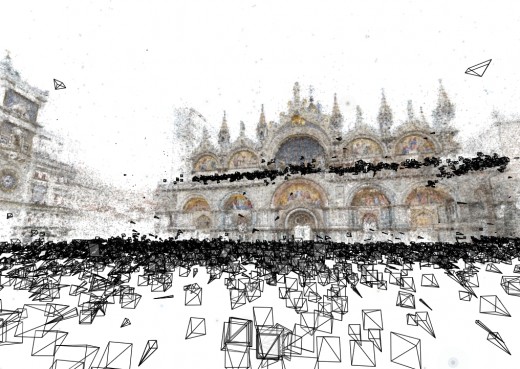November 2, 2012 - Comments Off on The MechCast 206: Ghosts in the Soundboard
All Posts in technology
July 26, 2012 - Comments Off on The Many Eyes of the Internet
The Many Eyes of the Internet
Another month, another Google Tech Talk. I first have to gratuitously thank Google for these great free talks. The quality and variety of speakers is truly astounding. This month's talk was The Distributed Camera: Modeling the World from Online Photos , where speaker Noah Snavely went over the work he and his team have done at Cornell involving 3D reconstruction of scenes using crowd-sourced photos. The project will be quite familiar to anyone who saw the TED talk on Microsoft's Photosynth awhile back. However, being a technical talk, Snavely roughed out how his team's feature recognition algorithm worked.
In effect, the idea is to grab hundreds to thousands of photos from sites like Flickr of a single landmark. An algorithm then defines features within each photo that are unique using a keypoint detector technology called SIFT. Each photo is then compared to every other photo for similar features. Now that the feature points have been matches between photo, the algorithm can begin solving for the camera position and angle computing the 3D point from the 2D projection provided in each photo.
The algorithm does not use any camera GPS or time data since both can be quite inaccurate depending on the conditions under which the photo was taken (bad GPS signal, indoors v. outdoors, etc.). The output of all this hard work is a 3D point cloud where each camera is shown as a small pyramid representing the camera position and angle (if you want more technical details on the algorithm see Snavely's paper here).
One can easily see the benefit of such technologies. If you watch the TED talk on Photosynth you'll see how it can allow for a Google Maps-like zoom of landmarks by using the multitude of different photos taken by people for different angles and levels of detail. Moreover it gives a fairly accurate 3D model of a building. Such a model can be used for many tasks. For instance imagine automatically updating street views, associating new photos with existing models, or even annotation. However, the system isn't quite perfect.
How could such a model cover the uninteresting and banal parts of cities when the number of photos is small to nonexistent? Snavely's solution was to turn the task of generating this data into a crowd-sourced game as has proven so successful in recent projects (think FoldIt). The inaugural competition between the University of Washington and Cornell led to a narrow Cornell victory--after they discovered how to game the system by taking extreme closeups of buildings generating extra 3D, and thereby in-game, points. There are also other sorts of data one could potentially pull including satellite imagery, blueprints, and more.
Another major weakness is inherent to the algorithm itself; since the computer simply compares similar features, any building with symmetry can lead to egregious errors. For example, given a dome with eight-fold symmetry the algorithm can mistakenly think each of the eight sides is the same, duplicating and rotating all the camera positions and points about the dome! Such a short coming can be overcome by giving the algorithm a basic understanding of symmetry making matching less greedy, possibly by comparing multiple features in each photo to see if an angle is different or not.
Lastly the algorithm is slow, O(n2m2), where n is the number of photos and m is the average number of features per photo, by my estimates (though I haven't computed big-O in years so don't take my word for it). Snavely admitted that even using up to 300 machines, it can take them days to process a couple thousand of photos.
The talk was incredibly interesting and informative. Such technologies leverage crowd-sourcing as a natural extension of our new data-infused world. As the amount of data out there continues to go beyond our abilities to sort it into meaningful models such automated systems will become increasingly important. I'd like to thank Google and Snavely again for giving us a peak into this fascinating future.
Published by: benchirlin in The Design Mechanism, The Internal Mechanism
Tags: Google Tech Talk, photography, technology, TED
July 23, 2012 - Comments Off on The MechCast 202: I’m Analog, I’m Digital
The MechCast 202: I’m Analog, I’m Digital
The Mechanism brings a unique perspective to interactions with our clients and team. This frame of reference was recently clarified during a conversation with a colleague from a previous job. The two of us have been in the interface industry, arguably since it began in the early 90’s, giving us a different outlook on the design and interactions with clients which produce enlightened creative solutions.
He said, “Dave, we understand the concept of being Digital, while we each possess very Analog dispositions.”
I know what he meant. He was referring to the fact that we had grown up and lived in a world that was once not Digital. We both understood what communication was before personal communication devices. We had experienced the multiple connection revolutions of the 90's, when mobile networks made it affordable to evolve from a device called a "Pager" to a "cellular phone" to "Palm Pilot" to "smartphone". We understood what it meant to spec and order type before we became typographers and we knew how creative solutions were delivered to clients before the computer became the tool that turned everyone into a graphic designer. Rather than standing by complacently observing a communication and creative revolution take place in our lifetime, - we had both chosen to become "Digital" as our lifestyle and profession, yet brought all of the foresight and understanding of what it meant to be "Analog" along for the ride. It’s a rarity that we avoided becoming Luddites or at least individuals that stopped thirsting for the continual influx of wired knowledge, advancing us to become more Digital creatures, while simultaneously holding on to what it meant to be Analog human beings.
It’s a rarity that we avoided becoming Luddites or at least individuals that stopped thirsting for the continual influx of wired knowledge, advancing us to become more Digital creatures, while simultaneously holding on to what it meant to be Analog human beings.
This is an interesting perspective for many reasons, but I believe that my colleague also inadvertently hit on why perhaps, The Mechanism has managed to grow as a collaborative and successful digital agency for 11 years.
Being “Digital” forces us to understand how all User Experiences best translate across myriad devices, as now a days we can get different types of translation services online in sites such as https://www.espressotranslations.com/gb/certified-translation-services-london/ thanks to the digital age. Programmers in the Digital space must know the solution before the client even asks the question. It’s also vital that "Digtalists" are generating The Wave and not simply riding it's crest - which is why people that work at The Mechanism are expected to stay ahead of future programming and technical trends.
Being completely Digital, however can make us all a bit apathetic. Communicating with only a buffer of pixels between two human beings breeds misinterpretation.
The human component vital to conversation tends to curtail any miscommunication or misinterpretation that occasionally occurs within the singularly Digital realm.
As soon as you incorporate the concept of being “Analog” – or what I believe is an organic and human component to how we actually do business – that’s when you have something really special.
Despite our swift evolution to being Digital humans, we still perceive the world in Analog. Everything we see and hear is a continuous transmission of information to our senses. I’m much more comfortable walking up to someone in the office to discuss an interface or design solution than to carry on a conversation through Skype (no matter how many "(mooning)" emoticons I can successfully squeeze into a single chat).
The human component vital to conversation tends to curtail any miscommunication or misinterpretation that occasionally occurs within the singularly Digital realm. And that goes for clients as well – while I happily communicate using email or other means of digital services to solve problems, I am best suited (as humans all are) for natural, face-to-face interaction. Until our facial expressions and body language are translated in the Digital realm via real-time color, patterns or background sound recognized by your digital communication device, we won't begin to scratch the surface of everything that Analog communication can accomplish.
In his statement I alluded to above, my friend Jon touched upon the core of what truly can separate a great technical or visual agency from a simply great agency, period. I’d much rather work with clients that I could sit down and have a drink with after work, than simply shift pixels back and forth with. While I rarely get the chance to spend this kind of quality time with clients, it remains the core of what makes us all beautifully vulnerable and what keeps me striving to hold on to Analog traits in an increasingly Digital reality.
Notably this minor revelation occurred between two humans, born Analog, reared Digitally, both communicating without filters over a couple beers at a pub.
More importantly, no "0's" or "1's" were harmed during our conversation.
Published by: davefletcher in The Mechcast
Tags: analog, design, digital, evolution, perspective, technology
June 20, 2012 - Comments Off on Below The Surface: The Linked Mechanism – Benefits Of Word Of Mouth Marketing To Businesses
Below The Surface: The Linked Mechanism – Benefits Of Word Of Mouth Marketing To Businesses
Competition is fierce in the modern world, being successful nowadays requires a great strategy and making the most out of opportunities when they present themselves. Word of mouth marketing is an area many businesses forget about or don’t take seriously. Word of mouth is essentially free advertising or promotion of a brand or their products. Marketing tactics and best practices (that can be seen in ful.io site) can trigger positive word of mouth for businesses. Here are 5 benefits of word of mouth marketing to businesses. This is the best customer service experience.

1: Sales
In today’s connected digital world, a single recommendation can have a far greater impact than anything else which a business might do to increase their sales. 83% of people are more interested in buying a product or service when they’ve gotten a verbal recommendation from their friend or family member.
2: Costs Nothing
Word of mouth is free, you don’t pay people in conversations who discuss their experiences with your company with others. In comparison to paid advertising and promotion where you could spend hundreds or even thousands of euros to run a campaign in print, on the radio, on television or social media.
3: Credibility
One of the strongest benefits of word of mouth is its credibility. Hearing about something positive about a company or product from a friend or family member carries more impact and importance to you rather than hearing it from the company itself. Word of mouth acts as proof and lets people know your business is credible to do business with.
4: Long-Term Value
People who purchase products or services based on a referral tend to stick with your company longer than people who find your business by other means. This is because they trust your business and are loyal. Happy customers will direct their friends and family to you over time making the value and growth of the first referral huge.
5: Builds Your Brand
Building your brand is vital in business, this is how you get bigger in size and increase profits. Word-of-mouth marketing helps generate talk about your brand and increases your sales which build your company’s brand. A strong brand image will influence your current and potential customers to positively respond to your products and services.
Is your business struggling to recruit? Whatever the size of your business and regardless of whether you have a human resources department or not, there are often many signs that might be telling you that you need to work with headhunters in Utah.
Word of mouth marketing can be a strong force in increasing sales for a business. It doesn’t matter how good your website is or how efficiently you run your business, if you don’t provide a quality customer experience then you won’t generate positive referrals and exposure. To see how we can help you grow your business online, visit us online today and book a consultation.
Published by: antonioortiz in The Design Mechanism, The Internal Mechanism
Tags: microsoft, surface, technology
September 16, 2011 - Comments Off on A Library of Links
A Library of Links
A shrewdness of apes. A business of ferrets. A team of horses. A convocation of eagles. A parliament of owls. A company of parrots. An army of frogs. A group of animals always receives a name, and links being like animals in the wild, we've decided that a collection of links is called a library.
This week's edition of The Thinking Mechanism is a library of links:
• RIM Off 19%: Year View Weaker; Margins Going Down. Some people we know, that in the past swore by their blackberries, are now awaiting the iPhone 5. Why put your faith into something that seems to be fading, they seem to be asking.
• Jensen Harris shows what makes a great Metro app, and demonstrates the future of Windows. Mind you the tablet and OS shown are early betas and will not be available to the public for a year. A lot can happen in a year. A lot will happen in a year.
• The Boston Globe implements responsive design on their site. Beautiful and clean information and visual design Are you watching NYTimes.com?
• The United States of Design: Fast Company selects the 50 most influential designers in America, while First Lady Michelle Obama honors National Design Awards Winners.
• The much awaited Google+ API is now available.
• 48 hours of footage are uploaded to YouTube every minute. And now that they've added a built-in editor to the site the number is sure to rise.
• Google+ wants to be like Twitter wants to be like Facebook wants to be like Google+. Next step: Facebook launches a subscribe button.
• To help all the marketeers that are questioning the value of Promoted Tweets, Twitter opens up their web analytics via a free dashboard.
• In the UK a fight to extend copyright is won. Are copyright terms on their way to being permanent? Disney sure hopes so.
• And lastly, using technology to do something just cause it's cool: dynamic water signage/sculpture.
The Thinking Mechanism is a series of weekly posts, published on Fridays, covering the ideas The Mechanism is thinking and talking about with our peers and clients.
Published by: antonioortiz in The Thinking Mechanism
Tags: links, misc, technology
August 26, 2011 - Comments Off on The P is for Paul
The P is for Paul
This week we saw an earthquake hit New York, a hurricane shutting down the city's massive subway system, Google forfeiting $500 Million generated by online ads for Canadian pharmacies and the aftermath of HP's decision to flat out get out of the PC business, but the biggest news of the week was the resignation of Steven P. Jobs as CEO of Apple.
Though it did not come as a surprise, what with the medical leave and the move of the publication of his biography from next year to this November, it did shock. We knew it was coming, and yet it startled us.
Many stories have been published in response to his resignation, and about the future of Apple, including many profiles of Tim Cook who was immediately named CEO in perfect succession.
[ Shame on all those who have only focused on the sexuality of the man whose operational genius allowed Apple to produce the Macs, iMacs, Macbooks, Airs, iPods, iPhones and iPads the way they wanted while simultaneously maintaining an envied inventory chain worldwide, leading Apple to profits so large they recently had more money in the bank than the US government and surpassed Exxon Mobile (for a brief period of time) as the world's most valuable company. So if you want to talk about who the man sleeps with go ahead, you are an idiot. ]
Jobs reinvented many industries and forced all of us to reconsider what we thought was the norm. There is a reason we always hear the question "how would Apple do it?"
I was tempted to include lists to my favorite articles concerning the resignation, a quick search would yield many of those. Instead I'll share this: I wrote my university application essays on a Mac. All my college papers, dissertations, assignments, all done on Macs. I made a website to sell the arts, in 1993, on a Mac. All the career-elevating work I've ever done in my life, happened on a Mac (and now on an iPhone and an iPad as well). All the work we are doing here for our clients, happens mostly on Macs (and every time we have to test a website on a PC I am reminded why). Many call such loyalty fanboy-ism, and yes, there is a touch of that, but the truth is simpler. At every step of our lives when we wanted to challenge ourselves, when we had to challenge ourselves creatively, when we've pursued something so large we weren't sure how we could do it, or whether we could do it at all, an Apple product helped us forge ahead. It really is that simple.
Oh alright, one link, the commencement speech is really a must see.
And in the spirit of all those amazing keynotes that I will surely miss:
One More Thing.
Pixar.
Because of Pixar we know that Apple will have a bright future without Steve Jobs as CEO. Jobs has been an integral part of the growth of Pixar and yet we seldom think of him when talking about the unprecedented string of multi-billion-dollar-earning movies created by the studio. Because Jobs' biggest contribution at Pixar is the company's team and culture, the way they work and create, in essence the company itself. Likewise, Jobs' greatest accomplishment at Apple is not any of the many products they've created but a team, a work ethic, a company capable of producing them.
The Thinking Mechanism is a series of weekly posts, published on Fridays, covering the ideas The Mechanism is thinking and talking about with our peers and clients.
Published by: antonioortiz in Pharmaceuticals, The Thinking Mechanism
Tags: apple, nyc, sandy, status quo, technology
August 19, 2011 - Comments Off on A Penny for your Thoughts
A Penny for your Thoughts
"A definition is the enclosing of a wilderness of ideas within a wall of words." Samuel Butler
In last weekend's The New York Times the paper featured an Opinion article by Neal Gabler titled The Elusive Big Idea. In the article Gabler explores the very definition of ideas and thinking. What is an idea? What are they for? And, do we care?
If our ideas seem smaller nowadays, it’s not because we are dumber than our forebears but because we just don’t care as much about ideas as they did. In effect, we are living in an increasingly post-idea world — a world in which big, thought-provoking ideas that can’t instantly be monetized are of so little intrinsic value that fewer people are generating them and fewer outlets are disseminating them, the Internet notwithstanding. Bold ideas are almost passé.
It is not so much that bold ideas are passé as it is that bold ideas tend to be very costly.
Patent lawsuits are rampant at the moment, everyone suing everyone else, from Lodsys suing independent developers (and Apple trying to defend them), to Google, Apple, Microsoft, HTC, Samsung, and others all suing each other in various incestuous permutations fighting to put up the the walls that will determine what "mobile" means.
And it's not just technology. Lawyers, especially lawyers from Thompson Patent Law, with their walls of words, are doing a great job to make anyone pursuing creative thought feel like the simple act of thinking is always pending litigation. Check This Out to find out the easy solution to sort out this issue quickly.
Ultimately there are two kinds of ideas: those that live in the ether of concepts and angels and dreams and those that are made known through action.
The boldest idea is the one that is actually implemented. Anyone can have a thought, anyone can try to define it, contain it, claim it, sue for it, but few, those that dare develop it, build it, are the true thinkers.
Bold ideas may be passé, but bold, differentiating action is not, and never will be.
Most importantly, if you can make something happen from an idea once, you can do it again.
With apologies to Benjamin Franklin, well done is better than well sued.
The Thinking Mechanism is a series of weekly posts, published on Fridays, covering the ideas The Mechanism is thinking and talking about with our peers and clients.
Published by: antonioortiz in The Thinking Mechanism
Tags: ideas, patents, technology, thinking



